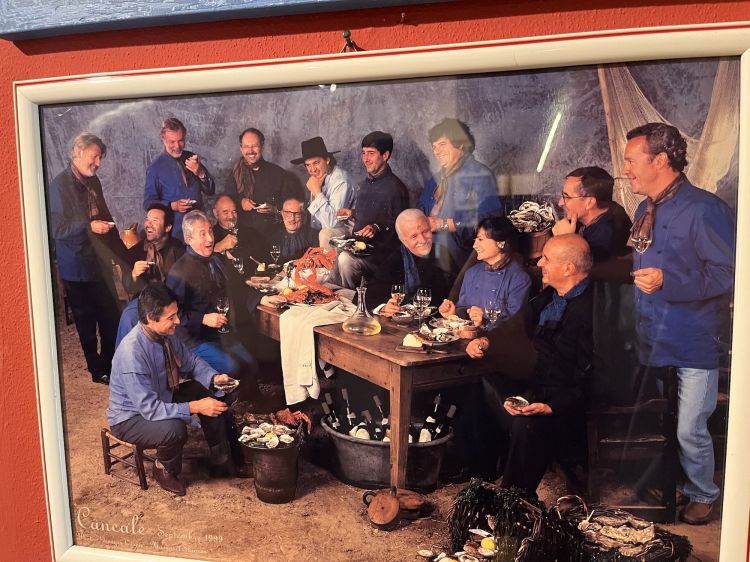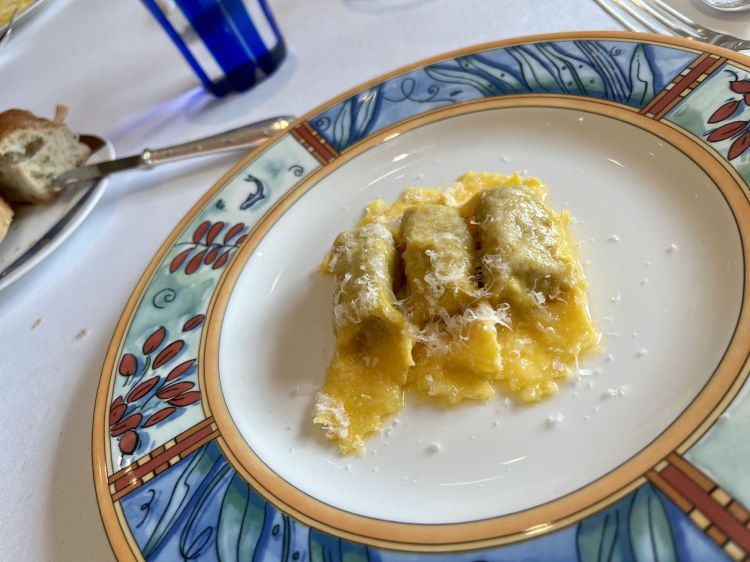‘I met Nadia in 1973. We were studying political science in Milan. We got married the following year, on the 6th of May. We had to wait for her parents' signature because she was still a minor - at that time you turned of age at 21. For our honeymoon we chose France. Those were extraordinary times but also terrifying: over the next fifteen years, at least ten of our regular clients were kidnapped.’
To have lunch with Antonio Santini is to retrace half a century of events that transformed the country. A hundred years almost, we could also say, referring to the year when Dal Pescatore di Canneto opened, in 1925. ‘Back then it was called Vino e Pesce (Wine and Fish) and his grandfather ran it. His name was Antonio, like mine. He married Teresa Mazzi, a lady born in Brazil to Italian parents, in Isola Dovarese. He was a ferryman: he took boats from one side of the river to the other. He rode on a bicycle selling freshwater fish from the basket. He was the pescatore, fisherman'.
Mamma Bruna and Papà Giovanni then introduced their son Antonio to fine food: 'They used to take me to Cantarelli and Colombani, the ante-litteram Italian haute cuisine. I used to bust my chops every time: 'I would have put less celery in the agnoli. If the broth is too hot the pasta dissolves and you lose the pleasure'. He thus began to work permanently in the farmhouse in the hamlet of Runate in the early 1970s. From there, the epic of the world's most famous tortelli and 28 consecutive editions of the Michelin Guide with 3 Michelin stars - an Italian record - took off.

Alberto and Antonio Santini

The restaurant has boasted 3 Michelin stars since 1996, so 28 consecutive editions - an Italian record
Nadia and Antonio have experienced so much in their 50 years together. ‘We have lived through all the phases, from nouvelle cuisine (the movement's manifesto was written in 1973,
ed.) to Nordic cuisine. From the time when, if you didn't do traditional cuisine, you were nobody, to the time when it was necessary to be innovative. Sinusoidal trends. But, in changing moods, the important thing is always to maintain a line, an identity'.
This is, perhaps, the most important lesson from the house in Runate. Reading the late winter 2023 menu, many dishes ahve had the same names from years - in some cases decades. But it is an exercise constantly striving to perfect the only apparent imperfectibility of tortelli and lobster terrines, of foie gras escalopes and soufflés. Not a schizophrenic reshuffling of the cards - as customary in the most prominent tables of the last twenty years, terrified of repetition - but a stable adaptation of the past to the present, carried out from time to time by the generations that pass on the baton without tears or guilt.
The challenge has long been taken up by the fourth generation, that of
Giovanni and
Alberto, born in 1976 and 1982. Two guys who face the challenges of cooking and dining with two heavy parchments in their pockets: a degree in Food Science and Technology and another in Economics and Commerce. Antonio lights up: 'We always talk about
Gino Veronelli or
Paul Bocuse (who called Dal Pescatore the best restaurant in the world,
ed.) but we must all strive to value young people. They have superior knowledge and are less hypocritical than us: I used to lie to convince banks to give us loans, they would never do that.’

Lorenzo Chinosi, waiter. ‘Why does nobody want to be a waiter these days?’ we ask Antonio Santini. ‘Because the restaurant owners don't pay them enough.’

The restaurant is a collection of great and prestigious memories. In the photo, Nadia Santini at a retreat in Cancale in 1999: among others, there are Pierre Gagnaire, Michel and Pierre Troisgros, Alain Senderens, Marc Veyrat, Fulvio Pierangelini, Paul Bocuse, Michel Bras and Alain Passard
However, Giovanni, Alberto and
Valentina - Giovanni's wife - had the lucidity to insist on an important project, against their father's initially sceptical, if not contrary, opinion: buying the farm opposite. 'In Runate there are 25 inhabitants,' intervenes second son Alberto, 'with the former owner of the farm we have always had a wonderful relationship. ‘I have been thinking of selling and I would like to sell to you’, he told us. We did all the necessary evaluations and decided to buy, in 2016. We left the fields fallow for three years, to regenerate. The other farmers would ask us to rent it out to plant their things but we always refused. In the pandemic, it was full of poppies. Today it is, and will increasingly be, our vegetable reservoir.’ And animal too, given the experimentation they are conducting with a small herd of scottone cows.
A sensible adjustment to the times of sustainability and self-production, which, however, would remain a sterile exercise for customers if it lacked the legendary sense of homeliness. ‘We struggle to conceive a life outside our restaurant. It is our daily life, we do not consider any other home but this one. When guests leave we always also feel a slight sorrow because you don't know when they will return.’ What’s certain is that, sooner or later, it will happen again.
From the March 2023 menu at Dal Pescatore

There are two tasting menus available at Dal Pescatore: 'Menu di Stagione' (€210, 7 courses) and 'Menu del Pescatore' (€290, 10 courses)

Acquadelle salad with garden salad and mayonnaise
A very pleasant entrée dominated by a salad of saltwater fish in the photo. Not in the picture, a tuile of 24-month Parmigiano Reggiano, a brisè pastry boat with sour cream and smoked salmon and a focaccia nostrana with Parma ham

Lobster terrine with Oscietra Royal caviar and extra virgin olive oil
A historical dish that has undergone many evolutions over time: initially it included salmon and lobster, but after the Chernobyl disaster salmon dropped off the restaurant's radar. At one time they served it with Champagne jelly, or at least some acidic wine to counterbalance the sweetness. Now a lot of work is done on the reduction of garden vegetables. Next to it there’s marinated ginger to alternate when tasting the terrine. In the glass, an Austrian Sauvignon Blanc from Tement

Winter vegetable garden with Savoy cabbage, artichokes, marinated sea bream and cannellini bean cream
A very pretty bouquet of vegetables from the new farm, purchased in 2016, right opposite the restaurant

Plain petit gris snails with herb and sweet garlic sauce Another great classic from Nadia and Giovanni Santini, an evergreen in an era when snails seem less popular than they once were (wrongly)

Pan-fried foie gras with raisin wine and passion fruit sauce
With the foie gras they serve a glass of Capitelli by Anselmi, a sweet wine made from Garganega grapes, the same from which the dish's sauce is made. A timeless classic (ethical implications permitting)

Tortelli di zucca al burro e parmigiano (pumpkin, amaretti, mostarda, Parmigiano)
One of the signature dishes of Italian cuisine of the last half century. 'Actually,' says Antonio Santini, 'my grandmother Teresa would already make tortelli. Then my mother Bruna made them even better, Nadia even better, and this one is Giovanni's version: the selection of the pasta is even more accurate, it has a consistency that better expresses the harmony of the American pumpkin, which we always get in the area between Viadana and Sabbioneta. This year they are extraordinary but the quality is not constant over the years, of course, it depends on the weather'. To match, the sommeliers serve an Alsatian riesling Clos Saint Landelin 2018

Risotto with goat's cheese fondue and saffron honey
The cheese comes from a small dairy in Brignano Gera d'Adda, in the province of Bergamo, and is called Lavialattea (the risotto is exquisite in its creaminess and spicy sweetness)

Grilled eel with green radicchio from the garden
The eel is caught in the Po Delta, explains Santini, 'and not from the rivers, which are polluted'. Upon tasting it, the supposed fatness becomes finesse. They serve it with a glass of 2015 Pommard from Burgundy by Jean-Marc Boillot

Saddle of venison with Cabernet and bilberry sauce

Orange soufflé with passion fruit coulis
Technical and stylistic perfection
Translated into English by Slawka G. Scarso